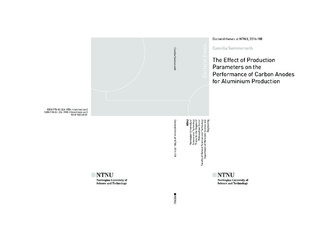| dc.contributor.advisor | Svensson, Ann Mari | |
| dc.contributor.advisor | Skybakmoen, Egil | |
| dc.contributor.advisor | Ratvik, Arne Petter | |
| dc.contributor.advisor | Lossius, Lorentz Petter | |
| dc.contributor.author | Sommerseth, Camilla | |
| dc.date.accessioned | 2016-04-25T12:16:00Z | |
| dc.date.available | 2016-04-25T12:16:00Z | |
| dc.date.issued | 2016 | |
| dc.identifier.isbn | 978-82-326-1555-1 | |
| dc.identifier.issn | 1503-8181 | |
| dc.identifier.uri | http://hdl.handle.net/11250/2387203 | |
| dc.description.abstract | Carbon anodes are essential when producing aluminium. Oxygen from dissolved aluminium oxide reacts electrochemically on the carbon anode forming CO2. The carbon anode is consumed during the process. The production of aluminium happens according to the electrochemical reaction:
2Al2O3 (diss) + 3C (s) = 4Al (l) + 3CO2 (g)
Carbon anodes are produced from calcined petroleum coke and a pitch binder. Anisotropic sponge coke was traditionally used as anode grade coke; however, the increased production of aluminium in the world has led to an increase in the demand for anode grade coke. Isotropic coke that was previously graded as fuel grade coke is being tested as anode grade coke in blends by some smelters around the world. In this work a series of pilot anodes have been made where the effect of blending isotropic coke into anisotropic coke was investigated. The pilot anodes were investigated both through characterisation techniques and electrochemical performance. Isotropic coke is higher in impurities (especially metals like vanadium and nickel, and sulfur) than many anisotropic sponge cokes and the increased impurity level can impose problems in the pot rooms. Also, the coefficient of thermal expansion between the two cokes is very different and this will cause increased cracking of anodes containing a certain level of isotropic coke. Cracking was observed in pilot anodes containing 35.0 wt% and 49.0 wt% isotropic coke. However, electrochemical testing showed that the introduction of isotropic coke to the pilot anodes proved positive in reducing the anodic reaction overpotential and also reducing the voltage oscillations caused by gas bubbles. Reducing the reaction overpotential can give a reduction in the energy consumption of the overall process, and reduction in voltage oscillations during bubble build-up and release will give more stable pots. It was also found that the wettability between the anode and the electrolyte was improved when isotropic coke was present. It is reasonable to assume a correlation between the reduction in voltage oscillations and improved wettability between anode and electrolyte.
The effect of the production parameters mixing temperature between pitch and coke, and baking temperature was also investigated in pilot anodes. A pilot anode line was prepared where the mixing and baking temperatures were varied: a high and a low mixing temperature and a medium and a low baking temperature. The electrochemical effect of varying these anode production parameters was small. However, the mixing temperature proved very important in order to produce homogeneous and dense anodes where the pitch had penetrated the coke well. | nb_NO |
| dc.language.iso | eng | nb_NO |
| dc.publisher | NTNU | nb_NO |
| dc.relation.ispartofseries | Doctoral thesis at NTNU;2016:108 | |
| dc.relation.haspart | Sommerseth, Camilla; Thorne, Rebecca Jayne; Rørvik, Stein; Sandnes, Espen; Ratvik, Arne Petter; Lossius, Lorentz Petter; Linga, Hogne; Svensson, Ann Mari.
Spatial methods for characterising carbon anodes for aluminium production. Light Metals 2015 ;Volum 2015-January. s. 1141-1146
<a href="http://dx.doi.org/10.1002/9781119093435.ch191" target="_blank"> http://dx.doi.org/10.1002/9781119093435.ch191</a> | en |
| dc.relation.haspart | Sommerseth, Camilla; Thorne, Rebecca Jayne; Ratvik, Arne Petter; Sandnes, Espen; Rørvik, Stein; Lossius, Lorentz Petter; Linga, Hogne; Svensson, Ann Mari.
Electrochemical Reactivity and Wetting Properties of Anodes Made from Anisotropic and Isotropic Cokes. Light Metals 2016 <a href="http://dx.doi.org/10.1002/9781119274780.ch146" target="_blank"> http://dx.doi.org/10.1002/9781119274780.ch146</a> | |
| dc.title | The Effect of Production Parameters on the Performance of Carbon Anodes for Aluminium Production | nb_NO |
| dc.type | Doctoral thesis | nb_NO |
| dc.subject.nsi | VDP::Technology: 500::Materials science and engineering: 520 | |
